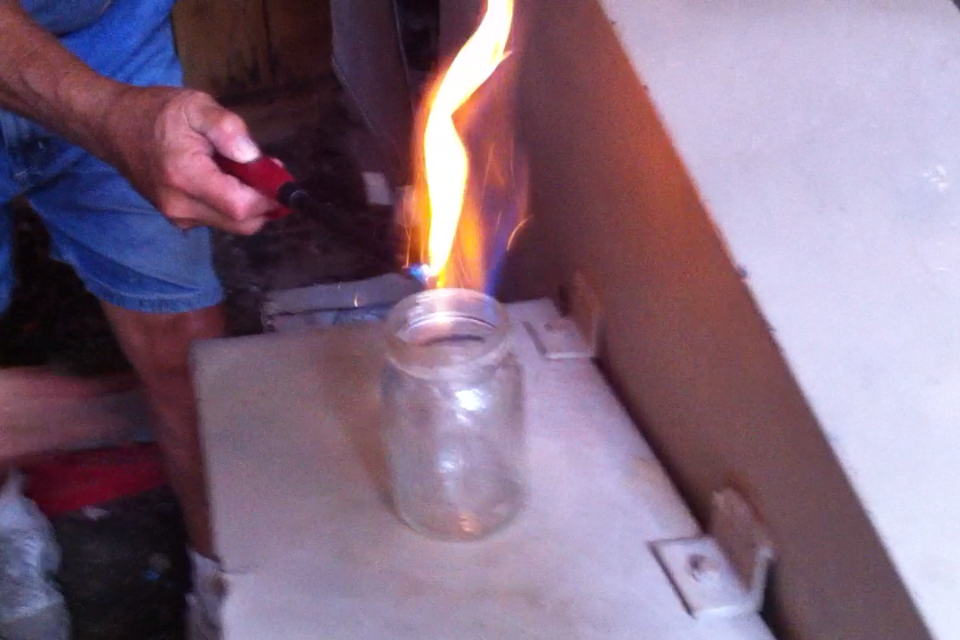
A Leroy Township, Bradford County resident lights a sample of methane gas on fire. The gas has been bubbling into puddles and creeks for more than two months.
Scott Detrow / StateImpact Pennsylvania


A Leroy Township, Bradford County resident lights a sample of methane gas on fire. The gas has been bubbling into puddles and creeks for more than two months.
Scott Detrow / StateImpact Pennsylvania

Scott Detrow / StateImpact Pennsylvania
A Leroy Township, Bradford County resident lights a sample of methane gas on fire. The gas has been bubbling into puddles and creeks for more than two months.

Scott Detrow / StateImpact Pennsylvania
A Leroy Township, Bradford County resident lights a sample of methane gas on fire. The gas has been bubbling into puddles and creeks for more than two months.
Michael Leighton’s problems began May 19. That’s when a neighbor called and asked if there was anything unusual about his water. “He said his [well] was bubbling over,” Leighton told StateImpact Pennsylvania. “I went down and looked at my well, and it was bubbling up.”
“I have 80 to 100 feet of headspace between my water and the top of my well,” Leighton said. “And the water actually boiled to the top.” The well, which supplies his drinking water, is located about 10 feet from Leighton’s house. He surveyed the rest of his property, and found nearly 20 miniature geysers squirting water and gas several inches into the air.
Soon, Department of Environmental Protection and Chesapeake Energy inspectors were on the scene. “My basement had very high levels of methane,” Leighton recalled. “At one point they gave us an evacuation notice.” Leighton and his wife Nancy refused to leave, though, so the fire department installed ventilation fans in the basement, and cut holes in his wall to pipe fresh air in.
Two months later, a ventilation pipe and filtration system installed by Chesapeake is removing the gas from the Leightons’ water. But flammable methane is still gurgling into the streams and wetlands on their property.
How does Michael Leighton know the methane is flammable? During an interview with StateImpact Pennsylvania, he watched as a neighboring property owner held a mason jar over a bubbling puddle, took the sample inside his shed, held a lighter over the jar, and unscrewed the lid. The gas caught fire, producing a brief, blue flame.
You can watch the video below:
Leighton has owned his Bradford County property for 10 years, and said he never saw any bubbling until May 19. What happened? The Leightons live about a half-mile from Chesapeake Energy’s Morse well pad. In a letter, Department of Environmental Protection Secretary Michael Krancer spelled out state regulators’ initial findings: They think natural gas escaped — migrated — through perforations in the Morse well’s casing during a bungled repair job. (Read the letter at the bottom of this article.)
The Department hasn’t reached any final conclusions yet, but this wouldn’t be the first time Chesapeake drilling has created problems in Bradford County. In April 2011, a Chesapeake well suffered a blowout, and spilled more than 10,000 gallons of hydraulic fracturing fluid into a Leroy Township field. Some of the fluid made its way into a nearby creek, and state regulators eventually slapped Chesapeake with a $190,000 fine.
One month later, Chesapeake Energy was hit with a $900,000 fine — the largest environmental fine in Pennsylvania history — for failing to fix faulty well casing that caused methane gas to seep through the ground and into 16 Bradford County families’ water supplies.
In fact, the very well pad that state regulators think contaminated the Leightons’ water supply was cited for “improper well casing” in August 2010. (Check out the well and violation information with StateImpact Pennsylvania’s interactive Shale Play app.)
The Morse pad’s damage isn’t limited to Leighton’s property, either. On June 8, the Clean Air Council, an environmental group, documented what it characterized as a “plume” of methane gas hanging over portions of Leroy Township. According to the group’s report, “The size and rate of expansion of the plume suggested large amounts of methane were being emitted into the atmosphere.”

A picture acquired by StateImpact Pennsylvania shows the Tioga County methane geyser five days after it first appeared.
It’s not clear when either methane migration problem will subside. A Department of Environmental Protection spokesman said Shell’s efforts to plug the abandoned well “could take some time.”
In a letter to the Clean Air Council about its Bradford County air quality study, Department of Environmental Protection Secretary Michael Krancer said the Chesapeake-related situation “is for the most part over.” (Read the letter at the bottom of this article.) But StateImpact Pennsylvania documented the migration on Michael Leighton’s property — as well as consistent bubbling in nearby Towanda Creek — four days after Krancer sent this letter. Leighton, who’s still dealing with regular methane inspections, clunky machines in his basement, and flammable gas on his property, doesn’t feel like the situation is “for the most part over.”
“The newspapers keep minimizing the damage here, but it’s here,” Leighton said, while pointing out the bubbling methane in the woods near his house. “And people think we’re radicals, but we’re not. We’re just upset about the condition of our property, and we want things fixed. I want my real estate back to where it was before. And right now, it ain’t worth dirt.”
Read DEP Secretary Michael Krancer’s letter to the Clean Air Council, which details DEP’s preliminary findings on Leroy Township’s methane problems:
StateImpact Pennsylvania is a collaboration among WITF, WHYY, and the Allegheny Front. Reporters Reid Frazier, Rachel McDevitt and Susan Phillips cover the commonwealth’s energy economy. Read their reports on this site, and hear them on public radio stations across Pennsylvania.
(listed by story count)
StateImpact Pennsylvania is a collaboration among WITF, WHYY, and the Allegheny Front. Reporters Reid Frazier, Rachel McDevitt and Susan Phillips cover the commonwealth’s energy economy. Read their reports on this site, and hear them on public radio stations across Pennsylvania.
Climate Solutions, a collaboration of news organizations, educational institutions and a theater company, uses engagement, education and storytelling to help central Pennsylvanians toward climate change literacy, resilience and adaptation. Our work will amplify how people are finding solutions to the challenges presented by a warming world.